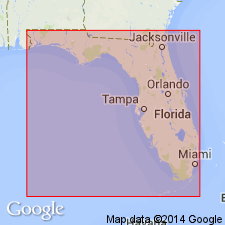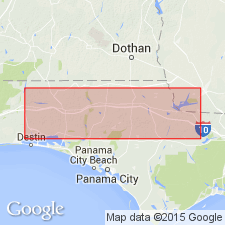
- Usage in publication:
-
- Yellow River formation
- Modifications:
-
- Named
- Dominant lithology:
-
- Clay
- Sand
- Silt
- AAPG geologic province:
-
- Mid-Gulf Coast basin
Summary:
Unit referred to YOLDIA faunizone contains clays, sands, shell beds, and silt that are similar to sediments in Shoal River Formation. If data developed in core drilling determines that lithologic separation can be made between Shoal River Formation, ARCA faunizone, and YOLDIA faunizone, Yellow River Formation is suggested as suitable stratigraphic name for YOLDIA faunizone. Thickness 10.5 to 11.5 ft at type locality. Underlies Red Bay Formation (new); overlies Tamiami Formation. Assigned to Choctawhatchee Stage.
Source: GNU records (USGS DDS-6; Reston GNULEX).

- Usage in publication:
-
- Yellow River
- Modifications:
-
- Not used
- AAPG geologic province:
-
- Mid-Gulf Coast basin
Summary:
Alum Bluff Group referred to as undifferentiated in this report. Because formations assigned by previous workers were differentiated on the basis of micro- and macrofossil faunas and implied age, not lithology, and do not satisfy the requirements of the Code, they are not used by this author. Alum Bluff is described in several outcrops and includes sediments differentiated as Chipola, Shoal River, Oak Grove, Whites Creek, Choctawhatchee, Red Bay, and Yellow River by others. Outcrop 10, at Red Bay, Walton Co., was previously referred to as the Choctawhatchee, the middle unit of the Alum Bluff by Matson and Clapp (1909). This outcrop of undifferentiated Alum Bluff was also considered to be the type locality of the "short lived" Red Bay Formation of Choctawhatchee age by Puri and Vernon (1964), which supposedly overlies Yellow River Formation. The type locality of the Yellow River is not one of the selected outcrops of this report.
Source: GNU records (USGS DDS-6; Reston GNULEX).
For more information, please contact Nancy Stamm, Geologic Names Committee Secretary.
Asterisk (*) indicates published by U.S. Geological Survey authors.
"No current usage" (†) implies that a name has been abandoned or has fallen into disuse. Former usage and, if known, replacement name given in parentheses ( ).
Slash (/) indicates name conflicts with nomenclatural guidelines (CSN, 1933; ACSN, 1961, 1970; NACSN, 1983, 2005, 2021). May be explained within brackets ([ ]).

